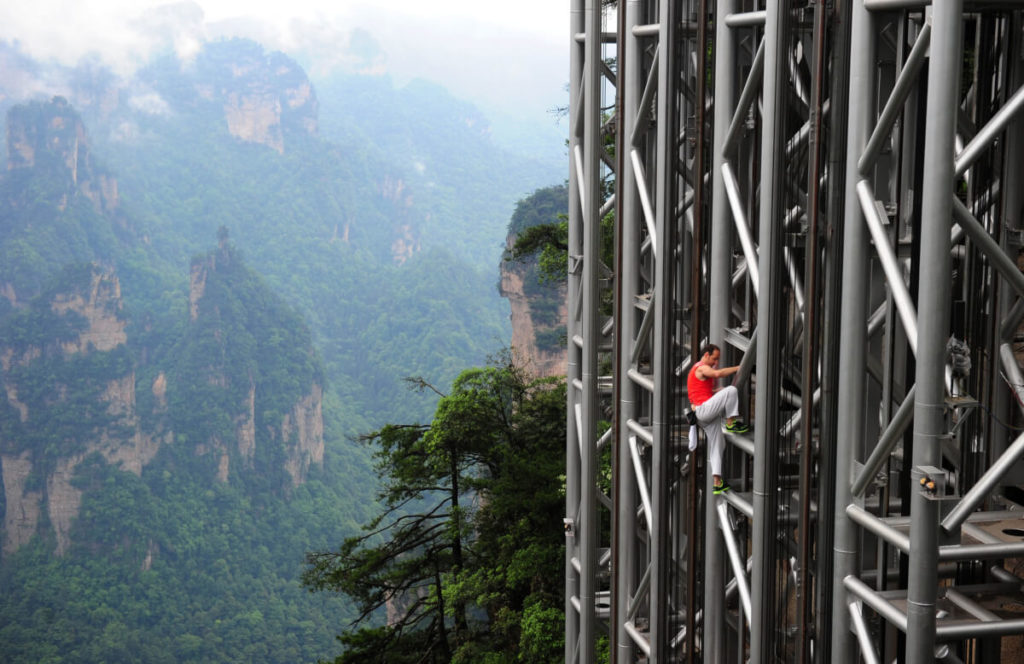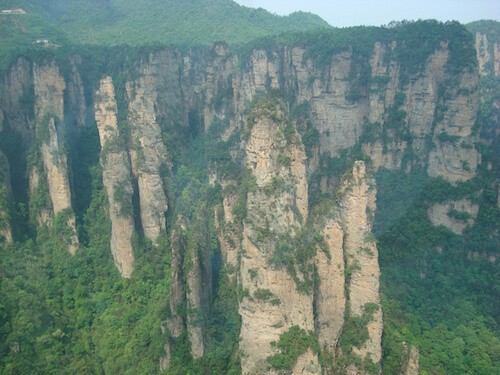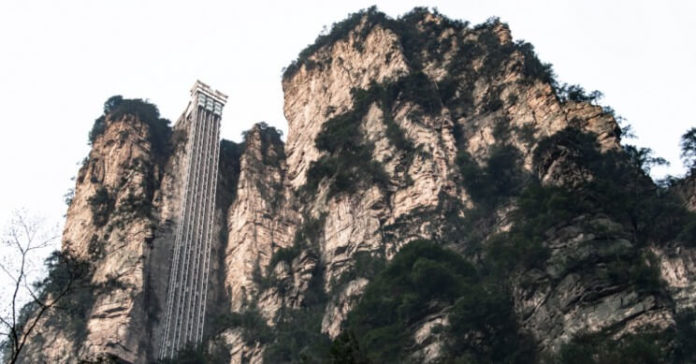Despite the controversy of its construction, there is no doubt the Bailong Elevator offers a fabulous and unique experience for visitors. It also provides a fantastic way to marvel at the natural beauty of the area and provide income for the local economy.
Bailong elevator is officially the tallest outdoor lift or elevator in the world, according to Guinness World Records. Its name means “Hundred Dragons Elevator.” Literally hewn into the side of a cliff in Wilingyaun area of China, the whole structure rises 326 meters up the cliff.
The incredible Bailong Elevator in Hunan, China was honored in 2015 at a special Guinness World Records certificate presentation event. Amazingly, the upper 171.4 meters of the structure is above ground and built literally into the quartzite cliff face. The lift allows passengers to get an impressive view over the area’s karst monolith rock formations.
The elevator has been open to the public since May of 2002 and ascending the structure takes a full minute and a half, more or less. Each elevator car has a weight capacity of 4,900 kg or about 50 people. The elevator transports around 1,380 people an hour per car.

The record breaker
The record-breaking ceremony was widely attended and hosted in the park in Hunan province. It was also a moment to celebrate the recent upgrading of the elevator’s ascent speed. The entire event was attended by Mr. Rowan Simons, the President of the Guinness World Records for Greater China. Mr. Simons was particularly impressed by the elevator’s state of the art facilities.
“It is our honor to verify this amazing achievement which not only provides a convenient transportation for tourists’ sightseeing, but also saves time for supplying materials of scenic spots as well as maximizing the protection of the local natural environment and ecological balance.” – commented Mr. Simons.
Building the Bailong Elevator
Work on the elevator began in 1999 and was completed in 2002 at a total cost of around £12 million or 120 million yuan, practically a steal.
The project was not without criticism at the time, however. The entire region is a world heritage site, and proposals for the project were met with opposition from environmentalists. Campaigners were concerned that the area already has a high saturation of tourists, around 5 million a year, and the environment wouldn’t benefit from another boost for attractions in the area.
The entire region was originally listed on the UNESCO list to preserve its original beauty. Supporters argued, however, that the elevators would save mountain trails from further traffic damage.
Lift shafts and tunnels were hewn from the quartz sandstone column, which was chosen specifically from thousands in the area. The lift cars are even fitted with earthquake detectors to allow them to be evacuated quickly in case of trouble.
Shortly following its opening in 2002, the elevator was shut down temporarily for safety concerns rather than environmental ones. It was soon reopened in 2003 and is now a favored tourist attraction for those with reckless abandon for heights.
154 meters of the elevator’s total height is sighted in mountain walls with the rest of the 172 meters exposed steel derrick and other components. The lift has three separate sightseeing elevators that run in parallel. The cars run at around 3 meters per second and can carry 4,000 people an hour if all three are in operation.
Bailong Elevator controversy
Despite opposition to its construction Chinese authorities insist the structure has helped protect rather than damage the region. They claim that the Environmental Assessment of the project concluded that its completion would help protect the world heritage site.
The area used to have plenty of hotels, guesthouses, and other accommodation facilities. These have all since demolished and removed which, it is claimed, decreases the impact on the environment during peak seasons. As the elevator has radically reduced the travel time of tourists in the region, visitors no longer need to stay overnight.
“I do not agree with the experts. They say building elevators will harm the mountain. But as we all know, the mountain is lifeless. When digging the tunnels, many steel structure and roof bolts were installed. They can consolidate the mountain. If a light earthquake happens, the mountain will be less vulnerable to collapse than others. So can you deny it’s protective?” – Sun Delong (Bailong Elevator Manager).
Opponents, on the other hand, took a very different view of the proposal during construction. The digging of tunnels and shafts, and constructions of steel structures in a world heritage site goes against the principle of protecting areas of natural beauty.

The geology of the area, which is quartz sandstone, means that large scale construction projects should really be avoided and tourist levels should be minimized to help preserve it. The site is and was a popular scenic spot that already suffers from heavy tourism. The addition of such a unique structure would further impact the area even if hotels were removed.
The elevator cars are fully glazed allowing visitors to get wonderful panoramic views of the outstanding beauty of the region. You can also scare yourself out of your wits by looking down as you ascend or descend if you like that sort of thing. The main assembly was designed and constructed by Rangger Elevator Company from Germany.
The elevator allows people to “go sightseeing up the mountain during the day, stay down the mountain at night in one day.” It provides great convenience for tourists who can save themselves from a very tiring walk along the alternative mountain trails. Plus, why walk when you can travel in style?
Despite the controversy of its construction, there is no doubt the structure offers a fabulous and unique experience for visitors. It also provides a fantastic way to marvel at the natural beauty of the area and provide income for the local economy.



















































